Many young children are given picture books as a source of entertainment, as they are growing up. The brightly coloured illustrations capture their attention. As we get older, the main attitude towards books without text is that they are not sophisticated enough or intellectual. Even young adolescences refer to them as childish. The view that most people have of illustration in books is that they act as an aid to help people visualise the text and to help the reader to understand the story better. It is assumed that as we mature, we grow more knowledgeable and therefore do not need illustration to help us understand the text. This is an attitude parents also have, mistakenly thinking that they don’t contribute to the development of their child’s literacy ability.
I believe illustrations reflect a lot more things than words can. For example, they tell us what the character looks like, what they wear, etc. They can also show by the way in which they are posed, if they are confident or not. Facial expressions can help to reflect what mood the character is in, in further detail. Illustrations can also reflect various things happening in a scene. However, illustration cannot tell us the finer details such as names, ages, etc nor can it tell us what’s happened in the past or what is planned for the future. For instance, take ‘Handa’s Surprise’ (Browne 1994), we would lose irony in the surprise. In the beginning, it’s a surprise for Handa’s friends, who Handa’s believes will love her present of exotic fruits. However by the end, it is Handa who is surprised when she discovers that all the different fruits have been replaced with tangerines. The illustrations act towards Handa’s surprise, as the text does not indicate what is happening in the images, without the illustrations the reader is oblivious to Handa’s surprise. The words and images coupled together add to the overall climax of the story. Therefore this is one thing that the picture book sacrifices; it’s the visual interpreter of the illustration, who is the narrator, in this case the child reading the book.
There are no written cues to tell the reader when to look at the illustration. For example in ‘Where The Wild Things Are’ (Sendak, 1970) when Max is sent to bed without any supper the reader will automatically look at his reaction in the illustration. Therefore, this makes the picture book much more taxing than people first anticipate. The child has to take information from the illustration; they have to assess every inch of the image whereas in a book with text you are able to just scan the image to understand what the text is referring to. This teaches the narrator new skills as they have to realise and consider the possibilities of the story. For example, if a child mistakenly interprets an image of someone getting out of bed in the morning, with somebody going to bed, this would disrupt the rhythm of the book.
What adults fail to remember is that in pre historic times, pictograms were used as a purpose of communication by Egyptians and they worked effectively. With the growth in inventions, such as television and the internet, I believe people think that these advanced improvements in technology, mean they are more effective in teaching. However, I believe that people forget to consider that these traditional methods can be used with great effect, as they are able to communicate on a global scale what things mean. For example, the use of pictograms in road signs shows that illustration can communicate to people on many different levels of ability and language.
In 1657, the first illustrated book was created; the title was ‘Orbis Pictus’. The principle of what the author was trying to achieve was linking the images and text together for readers to have a better understanding about the various topics discussed in the book. The picture book, therefore, proved to have a purpose and became the most popular text book in Europe over a century. The quaint illustrations designed on copper and wood helped children learn more easily as they would refer to the images as they read the text. Many people forget that most children are likely to be taught using the ‘show and tell’ technique. For example, a child wouldn’t be able to identify what a table was until they are shown it. Therefore the picture book enhances the ‘show and tell’ technique in many ways. A child was able to understand about an object’s existence and what it looked like even though the child may not have seen the object previously in his / her lifetime. Here is one of the images from the book depicting strong weather conditions, which may have not been experienced by the child. The text is numbered showing which part of the illustration it is referring to, making it very self-explanatory.
Rather than factually educating a child like the ‘Orbis Pictus’ book was used for, picture books may also imply wider social issues such as race and gender as well as individualistic concerns. For example, in the story ‘Jump’ (Magorian 2002) a young boy watches his sister in a ballet class. He turns to his mother and asks: “Mum can I go to dance class?”
His mother’s response is: “Certainly not. Real boys don’t go to dance class.”
Throughout the story a number of events occur to make his mum realise that he will actually make a wonderful dancer, despite the fact that he’s a boy. The story challenges the stereotyping of genders and what boys and girls should be seen to do. The young boy called Steven is shown through the illustration as energetic and enthusiastic for dance. Steven shows a persistent nature in going against what is deemed acceptable by his mother.
Ormerod cleverly illustrates three double page spreads to share with the reader a vague understanding of the boy in action. In the first spread boys are shown watching basketball on television. This indicates what young boys are seeing as acceptable to play, as it an all male sport. This makes the reader empathy with Steven’s frustration. In the second, you see Steven’s outburst of emotion whilst he is in his bedroom. In the third, you see Steven’s enjoyment as he bounces across the page. The page is action packed with movements reflecting his excitement. The message in the book reflects that boys can dance and should be allowed to do, if they wish.
The gender stereotype has always been played throughout children’s literature, as the authors want the reader to be able to relate to the characters in the book. Therefore you tend to see such scenarios as the mother staying at home looking after baby and dad going to work. However, as society is ever changing and the bridge between both genders is getting smaller, authors are forced to expand their perceptions to be able to reach new audiences. An example of this is the story ‘My Princess Boy’ (Kildavos, 2011) written by Cheryl Kilodavis and illustrated by Suzanne Desimone. It is a picture book about acceptance of what normally goes against the norm of stereotypes. She writes to enable both adults and children to act compassionately towards others if they are seen to be different. My Princess Boy is about a young boy who enjoys dressing up. In the images you see the young boy being accepted for who he is by his family. They picture Princess boys older brother in a basketball kit, showing that even though they have different interest they can still get on. The colours a warm expressing how the young boy feels with the support of his family. The characters don’t have detailed faces, however they feel is illustrated through their body language. Overall giving a message that its ok to go against the stereotype if it makes you happy.
There are many more issues that picture books deal with. For instance in Anthony Browne’s book ‘Gorilla’ (Browne, 1983) the book deals with the parent / child relationship as well as human beings and animals in captivity. The strain between the character Hannah and her relationship with her farther is immediately seen through the illustrations. The colours are very cold blue and grey tones in very angular shapes. There is also substantial space between the characters to make them look as two individuals rather than a family unit. In the illustration, it is common for the reader not to see the characters’ faces; however their emotions are evident through their gestures. As you can see by the tense stance of the body and Hannah’s hands directed away from her fathers in an awkward position. In image 2, you can see Hannah sat on her bed. The composition makes it look like she’s been imprisoned by the bars on her bedhead. The proportions in the image also make Hannah look very small which reflect the way she feels. The third image shows Hannah looking through the bars at a gorilla when visiting a zoo. The image is very sad as a viewer you can really depict the sense of loneliness and entrapment they both feel. When you see an earlier image of Hannah sitting in a corner of a room. She is in complete darkness with just the glare of light from the television. It really depicts the sense of emptiness in her life, without the love and attention from her farther. You also get the same feeling from the close up of the gorilla’s sad face, expressing that humans and animals are not so far apart in emotions. As the story progresses each theme is solved with a happy outcome. Hannah talks to her farther and they begin to understand each other better. Hannah has a meal with the gorilla, in which they both gain a mutual respect for one another. The feelings within the illustrations change dramatically, with warm vibrant colours and nice curved shapes; portraying a pleasant feeling.
Picture books for children usually always contain a moral, however what is to be considered is always the same, what is right or wrong?
Many authors that create these books have their own beliefs on the specific topic. For example, Foreman created two books about war, one of which was called ‘War Boy: A Country Childhood’ (Foreman, 1989). ‘War Boy: A Country Childhood’ is an autobiographical account of growing up in a coastal town during the Second World War. The text isn’t fluid unlike many other picture books. There are images such as posters from the war, as well as cartoon style sketches, pen and ink drawings and full colour paintings. The style in which the book is wrote, makes for an informative read on a very serious topic. However Foreman succeeds in lightening the tone, to make the story more suitable for children by adding humorous antidotes such as when he talks about “How to annoy old ladies”. Showing how a young child lived through the war engaged his imagination and telling the story from the child’s point of view makes the adults seem more hysterical.
The seriousness of the war is portrayed through the illustrations, enhancing the harsh reality of what was taking place. For example, in the image below you can see the young boy being pushed along by his mother to get to the bomb shelter quickly. The texture of the thick smoke, adds to the drama of the scene, which is furthered by the flowing movement throughout the image of people rushing away from the blaze of fire. The use of watercolour works well as the blotchy area depicts the hazy visual you would see through the smoke, also in contrast by painting quite quickly and loosely the strokes also depicts the panic of the mothers and the pace in which they are running. This book reflected the author’s knowledge about the war and his own experience. His attitude of war is also reflected in his sequel book the ‘War Game’ (Foreman, 2006). The conditions in which the solder fought are graphically depicted with illustrations of the trenches. There is also a section in the book, where soldiers from both England and Germany play football together. This scene is very peaceful and enjoyable both side finding relief, smiling and laughing together. This is in contrast to the images of them fighting. Setting the reader up to understand the devastation that comes next. The last few pages show an English soldier badly wounded and a German soldier dying nearby, again reinforcing the harsh reality of war. The last two pages are wordless; bright red poppies grow through a blanket of snow which has fallen on the ground. The stories and illustrations as a whole, document a time in history.
Foreman reflects his thoughts about war by conveying the naïve thoughts of young men entering the war, upon being targeted by recruiting posters and advertisements at the time. He also reflects that the young men who were in battle against one another, actually had a lot in common, both sides had a passion for playing football. The impression left with the reader is a fairly horrifying and sad feeling, the book reflects war as being senseless, something that Foreman has a strong view about, having lost four uncles in World War One, he actually dedicated ‘War Game’ to them. Teaching children that with victory, comes great sacrifice.
Overall therefore I believe that illustration should always be present in literature. They prove to enhance the written word. Images are able to add to text by reinforcing what is important, and also reflecting different viewpoints. This helps educate children so they can gain an informed opinion on subjects. Even in adult life when we are supposed to be competent readers. Many texts include images such as newspapers, magazines, advertisements, and maps, even to flat pack diagrams. This shows their diverse use in the modern day.

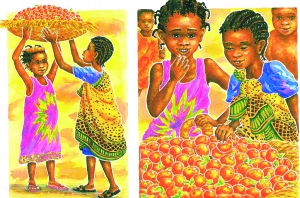



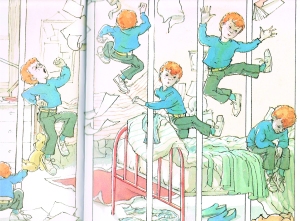


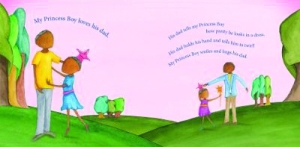




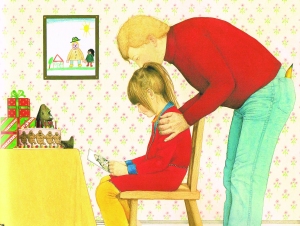

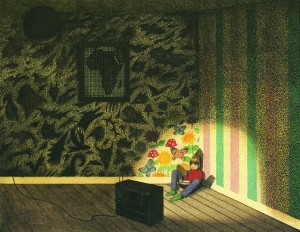


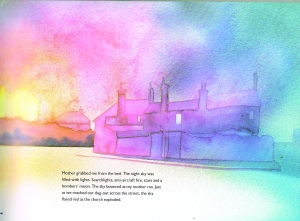

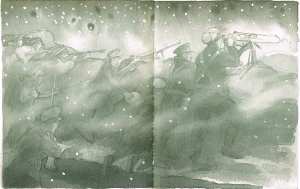



You must be logged in to post a comment.